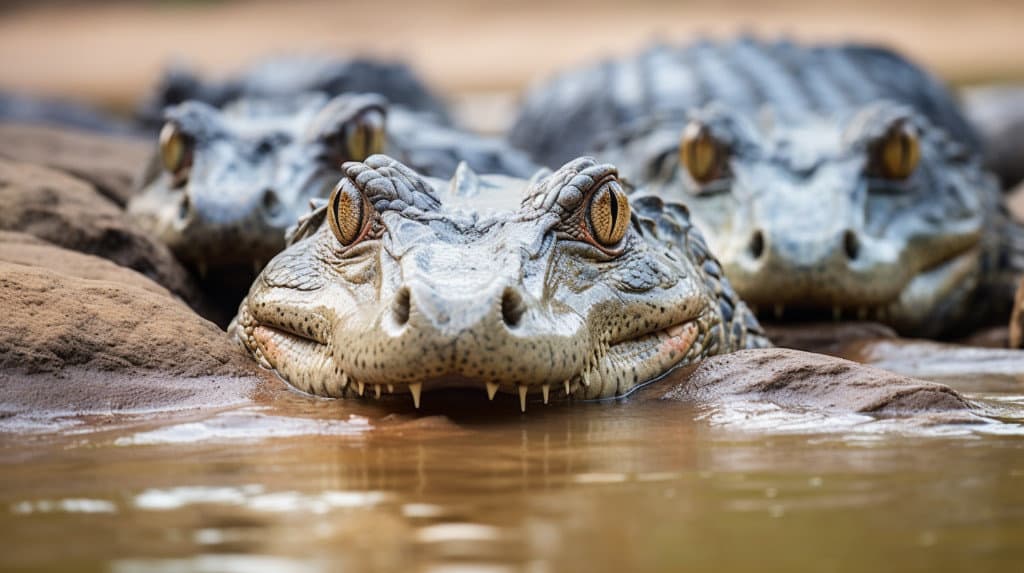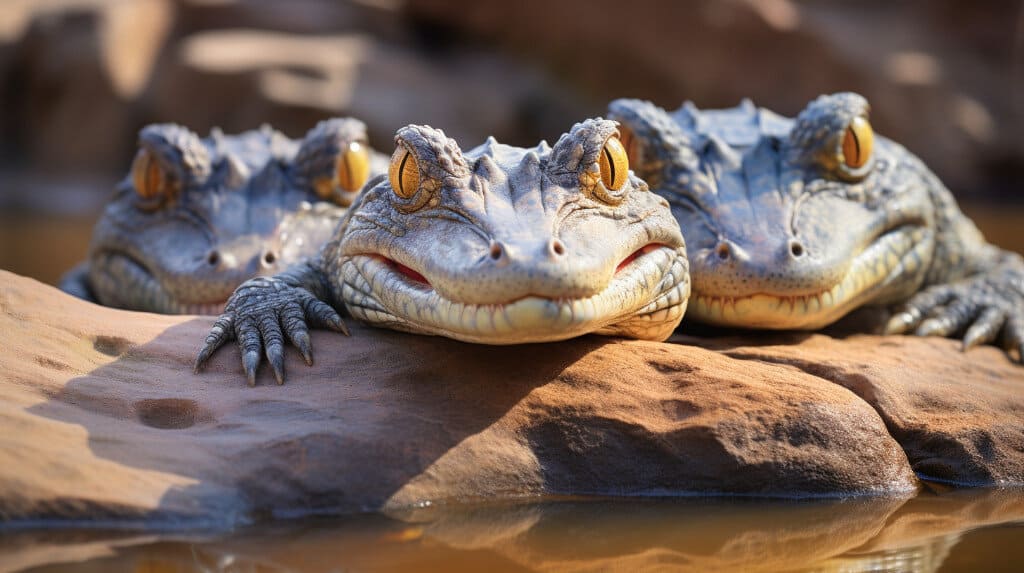Introduction:
Have you ever wondered what sound a crocodile makes? While we often associate crocodiles with their fearsome appearance and stealthy movements, their vocalizations are not as well-known. Contrary to popular belief, crocodiles do make sounds, although they are not as loud or frequent as those of other animals. In this article, we will explore the various sounds that crocodiles produce and what they might mean.
Key Takeaways:
| Sound | Description |
|---|---|
| Hissing | Crocodiles produce a hissing sound by expelling air through their nostrils. This sound is often a warning to potential threats or rivals. |
| Bellowing | During mating season, male crocodiles emit deep, resonant bellows to attract females and establish dominance. These bellows can be heard from a considerable distance. |
| Growling | When crocodiles feel threatened or agitated, they may emit a low growl, similar to that of a dog. This sound serves as a warning to back off. |
| Vocalizations | Crocodiles also produce various vocalizations, including grunts, roars, and chirps. These sounds are used for communication between individuals and can convey different messages depending on the context. |
Remember, while crocodiles may not be as vocal as some other animals, they do have a range of sounds that play a crucial role in their communication and behavior.
Understanding Crocodile Sounds
Crocodiles are fascinating creatures that inhabit various habitats around the world. One of the intriguing aspects of crocodile behavior is their vocalizations. These sounds play a crucial role in their communication and behavior. In this article, we will explore the basics of crocodile vocalizations and the purpose behind these unique sounds.
The Basics of Crocodile Vocalizations
Crocodiles produce a wide range of sounds, each serving a specific purpose. These vocalizations can be categorized into different types, including growls, hisses, bellowing, grunts, and calls. Let’s take a closer look at each of these crocodile noises:
-
Growls: Crocodile growls are deep, low-frequency sounds that are often associated with aggression or territorial behavior. These rumbling sounds can be quite intimidating and are used to establish dominance or warn off potential threats.
-
Hisses: Similar to snakes, crocodiles can hiss as a defensive mechanism. When feeling threatened or disturbed, they emit a sharp hissing sound to deter predators or intruders. This reptile sound is a clear indication that the crocodile is not to be messed with.
-
Bellowing: Crocodile bellowing is a powerful vocalization that is commonly heard during the mating season. Male crocodiles produce deep, resonating bellows to attract females and establish their dominance. These calls can carry over long distances, allowing potential mates to locate each other.
-
Grunts: Crocodile grunts are short, low-pitched sounds that are often heard during feeding or social interactions. These grunts can serve as a form of communication between crocodiles, indicating their presence or signaling their intentions.
-
Calls: Crocodile calls are a combination of various vocalizations, including growls, hisses, and grunts. These calls can be used for different purposes, such as territorial disputes or communication between individuals in a group.
The Purpose of Crocodile Sounds
Crocodile vocalizations serve several important purposes in their daily lives. Here are some key reasons behind these reptile sounds:
-
Communication: Crocodiles use vocalizations to communicate with each other. Whether it’s establishing dominance, warning off intruders, or attracting mates, these sounds play a crucial role in conveying messages within their social groups.
-
Territorial Defense: Growls and bellowing are often used by crocodiles to defend their territories. By producing these powerful vocalizations, they assert their dominance and ward off potential rivals.
-
Mating Rituals: During the breeding season, male crocodiles produce distinctive calls to attract females. These vocalizations help in locating potential mates and initiating the mating process.
-
Social Interactions: Crocodile grunts and calls are used for social interactions within their groups. These sounds help in maintaining group cohesion, coordinating activities, and signaling their presence to other members.
Crocodile vocalizations are not only fascinating but also essential for their survival and reproduction. These sounds of nature provide valuable insights into the behavior and communication of these incredible reptiles. Next time you hear a crocodile roar or hiss, take a moment to appreciate the complexity and significance of their vocalizations in the wild.
Note: If you’re interested in learning more about crocodile sounds, you can explore books on wildlife sounds or animal noises. These resources often provide detailed information on crocodile vocalization and behavior.
Different Types of Crocodile Sounds
Crocodiles are known for their unique vocalizations, which play a crucial role in their communication and behavior. These reptiles have a variety of sounds that they use to convey different messages. Let’s explore the different types of crocodile sounds and what they mean.
Hissing: The Warning Sound
One of the most recognizable sounds associated with crocodiles is their hissing. When a crocodile feels threatened or agitated, it will emit a loud hiss as a warning signal. This hissing sound is produced by expelling air forcefully through the nostrils. It serves as a clear indication to potential threats to back off and maintain a safe distance. The hissing sound of a crocodile can be quite intimidating, resembling a forceful release of air.
Bellowing: The Mating Call
During the mating season, male crocodiles produce a deep, resonating sound known as bellowing. This vocalization is used to attract females and establish dominance over other males. The bellowing sound is often described as a low-frequency roar that can carry over long distances. It serves as a way for male crocodiles to communicate their presence and readiness to mate. The powerful bellowing of a crocodile can be heard echoing through the swamps and rivers, creating an awe-inspiring soundscape of nature.
Chirping: The Distress Call of Baby Crocodiles
When baby crocodiles are in distress or separated from their mother, they emit a high-pitched chirping sound. This distress call helps them attract the attention of their mother or other nearby adult crocodiles. The chirping sound of baby crocodiles is often described as a series of sharp, piercing calls. It serves as a way for the vulnerable hatchlings to communicate their need for assistance and protection. Hearing the distress calls of baby crocodiles can evoke a sense of empathy for these young reptiles in their struggle for survival.
Growling: The Sound of Aggression
When two crocodiles engage in territorial disputes or confrontations, they may produce a growling sound. This deep, guttural vocalization is a sign of aggression and dominance. The growling sound of crocodiles is often accompanied by visual displays such as open mouths, bared teeth, and body posturing. It serves as a warning to the rival crocodile to back down or face the consequences. The growling sound of a crocodile can send shivers down your spine, reminding us of the raw power and primal nature of these ancient creatures.
Crocodile sounds are not only fascinating but also essential for their survival and social interactions. These vocalizations allow crocodiles to communicate warnings, attract mates, protect their young, and establish dominance. The diverse range of sounds produced by crocodiles adds to the rich tapestry of wildlife sounds in their natural habitats. So, the next time you find yourself near a crocodile habitat, listen closely, and you might just hear the captivating sounds of these remarkable reptiles.
The Sounds of Different Crocodile Species
The Saltwater Crocodile: A Unique Sound Profile
When it comes to crocodile noises, the saltwater crocodile stands out with its distinctive vocalizations. These reptiles are known for their ability to communicate through a variety of sounds, which play a crucial role in their behavior and mating rituals.
One of the most recognizable sounds of the saltwater crocodile is its deep growl. This low-frequency noise can be heard from a distance and is often associated with dominance and territorial displays. It’s a sound that sends a clear message to other crocodiles in the area.
In addition to growling, saltwater crocodiles also engage in hissing and bellowing. Hissing is a common defensive sound that they make when feeling threatened or agitated. It serves as a warning to potential predators or intruders to stay away. On the other hand, bellowing is a vocalization used during the mating season. Male crocodiles produce deep, resonating bellows to attract females and establish their dominance.
To give you a better understanding of the saltwater crocodile‘s sound profile, here’s a table summarizing their vocalizations:
| Sound | Description |
|---|---|
| Growl | Deep, low-frequency noise associated with dominance and territorial displays |
| Hiss | Defensive sound made when feeling threatened or agitated |
| Bellow | Resonating vocalization used during the mating season to attract females |
The Nile Crocodile: Distinctive Vocalizations
Moving on to another crocodile species, the Nile crocodile also has its own set of unique vocalizations. These reptiles are known for their powerful roars and grunts, which can be heard echoing through their habitats.
The roar of a Nile crocodile is a sound that commands attention. It is a deep, rumbling noise that can be heard from a considerable distance. This vocalization is often associated with territorial displays and serves as a warning to other crocodiles to stay away.
In addition to roaring, Nile crocodiles also produce distinctive grunting sounds. These grunts are often heard during social interactions or when communicating with other crocodiles. They can vary in pitch and intensity, conveying different messages depending on the context.
To summarize the vocalizations of the Nile crocodile, here’s a table:
| Sound | Description |
|---|---|
| Roar | Deep, rumbling noise associated with territorial displays |
| Grunt | Distinctive sound produced during social interactions and communication |
Crocodile noises are not only fascinating but also provide valuable insights into their behavior and communication. These sounds of nature add to the rich tapestry of wildlife sounds in their respective habitats. Whether it’s the saltwater crocodile‘s growl or the Nile crocodile‘s roar, these vocalizations are a testament to the diversity of animal noises in the natural world.
How Crocodiles Make Sounds

Crocodiles are fascinating creatures known for their unique vocalizations and ability to communicate with each other through various sounds. In this article, we will explore the intriguing world of crocodile noises and how these reptiles produce them.
The Role of the Larynx in Sound Production
Similar to other animals, crocodiles use their larynx, also known as the voice box, to produce sounds. The larynx is located in the throat and consists of vocal folds that vibrate when air passes through, creating distinct sounds. Crocodile vocalizations can range from low-frequency growls to high-pitched hisses, each serving a different purpose in their communication.
Crocodile growls, for example, are often associated with territorial displays and aggression. These deep, rumbling sounds can be heard from a distance and serve as a warning to other crocodiles to stay away. The powerful vocalizations of crocodiles are not only a means of communication but also play a crucial role in their behavior and survival.
The Influence of Body Size and Shape on Sound
The size and shape of a crocodile’s body also play a significant role in the sounds they produce. Larger crocodiles tend to produce deeper and more resonant vocalizations due to their larger larynx and longer vocal folds. On the other hand, smaller crocodiles may produce higher-pitched sounds.
To better understand the influence of body size and shape on crocodile sounds, let’s take a look at the following table:
| Body Size | Sound Characteristics |
|---|---|
| Large | Deep, resonant growls |
| Small | Higher-pitched sounds |
As we can see, the size of a crocodile directly affects the pitch and intensity of their vocalizations. This adaptation allows crocodiles to communicate effectively within their habitats and establish their dominance.
In conclusion, crocodiles have a remarkable ability to produce a wide range of sounds using their larynx. These vocalizations serve as a means of communication, territorial display, and even mating calls. Understanding the sounds of nature, such as crocodile noises, adds to our knowledge of wildlife and the fascinating world of animal behavior.
So, the next time you find yourself near a swamp or in a crocodile’s habitat, keep an ear out for the distinctive sounds of these incredible reptiles. It’s a truly immersive experience that connects us to the wonders of the natural world.
Why Crocodiles Make Sounds

Crocodiles are known for their powerful jaws and stealthy nature, but did you know that they also make a variety of sounds? These sounds serve important purposes in their communication and behavior. Let’s explore why crocodiles make sounds and the different contexts in which they use them.
Communication Among Crocodiles
Crocodiles are highly social creatures and use various vocalizations to communicate with each other. These sounds, often referred to as crocodile noises or crocodile vocalizations, play a crucial role in maintaining social bonds and establishing territories. By emitting low-frequency sounds, crocodiles can convey messages over long distances, even underwater.
Some common crocodile sounds include growls, hisses, and bellows. These reptile sounds can be heard in their natural habitats, such as swamps and rivers. Crocodile growls are deep and rumbling, while hisses are sharp and forceful. Bellows, on the other hand, are loud and resonating, often resembling a roar.
Attracting Mates with Sound
One of the main reasons why crocodiles make sounds is to attract potential mates during the breeding season. Male crocodiles produce distinct mating calls, which are a combination of growls, bellows, and grunts. These crocodile mating calls serve as a way for males to advertise their presence and dominance to females.
The intensity and frequency of these calls can vary depending on the species and individual. The louder and more impressive the call, the more likely it is to attract a female crocodile. It’s fascinating to think that these reptiles have their own unique way of serenading their potential partners!
Warning Off Predators and Rivals
Crocodile sounds also play a crucial role in warning off predators and rivals. When threatened or challenged, crocodiles may emit aggressive vocalizations to intimidate their opponents. These warning calls can include hisses, growls, and roars, which serve as a clear message to back off.
In addition to vocalizations, crocodiles may also engage in visual displays, such as opening their jaws wide or slapping their tails on the water’s surface. These combined behaviors create a formidable defense mechanism, deterring potential threats and maintaining their dominance in their habitat.
Crocodile sounds are not only fascinating to observe but also provide valuable insights into their behavior and communication. Whether it’s for socializing, attracting mates, or warning off rivals, these reptiles have developed a unique repertoire of sounds that are essential for their survival.
So, next time you find yourself near a swamp or river, keep an ear out for the distinctive sounds of crocodiles. It’s a chance to witness the sounds of nature and appreciate the incredible wildlife that surrounds us.
The Sound of a Crocodile Bite

Crocodiles are known for their powerful jaws and the distinctive sound they make when biting down on their prey. The audible snap of their jaws is a sound that sends shivers down the spines of both animals and humans alike.
The Audible Snap of Powerful Jaws
When a crocodile bites down on its prey, the force and power behind its jaws create a loud and unmistakable sound. This audible snap is a result of the crocodile’s incredibly strong bite force, which can exert pressure of up to 3,700 pounds per square inch (psi). To put that into perspective, a human bite force typically ranges from 150 to 200 psi.
The sound of a crocodile bite is not only a testament to its strength, but it also serves a practical purpose. It helps to immobilize and incapacitate the prey, making it easier for the crocodile to secure its meal. The loud snap can also serve as a warning to other potential predators or competitors, signaling that the crocodile is in control and ready to defend its territory.
The Role of Sound in Hunting and Feeding
Sound plays a crucial role in a crocodile’s hunting and feeding behaviors. While crocodiles are primarily visual hunters, relying on their keen eyesight to locate prey, sound can provide valuable information about the location and movements of potential meals.
Crocodile noises, such as growls, hisses, bellowing, and vocalizations, are not only used for communication but also for hunting. These sounds can attract prey, especially if they mimic the distress calls of other animals. By luring unsuspecting prey closer, the crocodile increases its chances of a successful ambush.
In addition to attracting prey, crocodile sounds can also intimidate and deter potential threats. The roar of a crocodile or its distress call can serve as a warning to other animals to stay away. This vocalization is particularly important during the mating season when male crocodiles use their calls to establish dominance and attract females.
Crocodile behavior and their use of sound have fascinated researchers and wildlife enthusiasts for years. The study of crocodile audio and sound effects has provided valuable insights into their ecology and behavior. It has also led to the creation of various wildlife documentaries and books that aim to capture the essence of these incredible creatures in their natural habitat.
So, the next time you hear the sounds of nature or swamp sounds, pay attention. It might just be a crocodile communicating, hunting, or asserting its dominance with its powerful jaws and unique vocalizations.
Note: For the best crocodile-related books, top-ranked sellers, and more, be sure to check out reputable sources and platforms that specialize in wildlife literature and information.
Conclusion
In conclusion, the sound that a crocodile makes is quite different from what we might expect. Unlike other animals that produce loud and distinctive calls, crocodiles are relatively silent creatures. They do not have vocal cords like birds or mammals, so they are unable to make complex sounds. Instead, crocodiles communicate through a variety of non-vocal signals, such as body movements, tail slaps, and hisses. These signals help them establish dominance, attract mates, and warn off potential threats. So, if you ever find yourself near a crocodile, don’t expect to hear a roar or a growl. Instead, be on the lookout for their subtle yet powerful non-vocal communication.
Frequently Asked Questions
What sound does a baby crocodile make?
A baby crocodile typically makes a high-pitched chirping or peeping sound. This is often used to communicate with their mother and siblings, especially when they are in distress or need help.
What sound does a saltwater crocodile make?
Saltwater crocodiles are known for their deep, throaty growl and hissing sounds. They can also make a unique bellowing sound during mating season to attract a mate.
What noise do crocodiles make?
Crocodiles make a variety of noises for communication. This includes growling, hissing, bellowing, and even a distinctive roar-like sound. The type of sound made can depend on the situation or the crocodile’s needs.
What does the crocodile sound like?
A crocodile’s sound can be described as a deep, throaty growl or hiss. During mating season, they can produce a unique bellowing sound. When threatened, they may emit a loud roar-like sound.
What noise does a crocodile make?
Crocodiles make a range of sounds including growls, hisses, bellows, and roars. The type of sound can vary depending on the crocodile’s situation, mood or needs.
What sound do a crocodile make?
Crocodiles make a variety of sounds, including grunts, growls, hisses, and bellows. They use these sounds to communicate with each other, during mating season, or to signal distress.
What noise does a crocodile make when it bites?
When a crocodile bites, it typically does not make a noise. However, the action of snapping its jaws shut can create a loud, powerful clapping or cracking sound due to the force involved.
What other sound does a crocodile make?
In addition to growls, hisses, bellows, and roars, crocodiles can also make a variety of other sounds. This includes grunts, chirps (especially from baby crocodiles), and even a purring sound, which is used for communication.
Why do crocodiles make noise?
Crocodiles make noise for a variety of reasons. These can include communication with other crocodiles, attracting a mate during mating season, signaling distress, or expressing dominance or territoriality.
What sound does a crocodile make in words?
Describing a crocodile’s sound in words can be challenging, but it is often described as a deep, throaty growl or hiss. During mating season, they produce a unique bellowing sound. When threatened, they may emit a loud roar-like sound.




